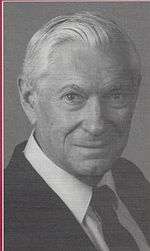Robert Plutchik

Robert Plutchik (21 October 1927 – 29 April 2006) was professor emeritus at the Albert Einstein College of Medicine and adjunct professor at the University of South Florida. He received his Ph.D. from Columbia University and he was also a psychologist. He authored or coauthored more than 260 articles, 45 chapters and eight books and edited seven books. His research interests included the study of emotions, the study of suicide and violence, and the study of the psychotherapy process.[1]
Theory of emotion
Robert Plutchik's psychoevolutionary theory of emotion is one of the most influential classification approaches for general emotional responses . He considered there to be eight primary emotions—anger, fear, sadness, disgust, surprise, anticipation, trust, and joy. Plutchik proposed that these 'basic' emotions are biologically primitive and have evolved in order to increase the reproductive fitness of the animal. Plutchik argues for the primacy of these emotions by showing each to be the trigger of behaviour with high survival value, such as the way fear inspires the fight-or-flight response.
Plutchik's psychoevolutionary theory of basic emotions has ten postulates.
- The concept of emotion is applicable to all evolutionary levels and applies to all animals including humans.
- Emotions have an evolutionary history and have evolved various forms of expression in different species.
- Emotions served an adaptive role in helping organisms deal with key survival issues posed by the environment.
- Despite different forms of expression of emotions in different species, there are certain common elements, or prototype patterns, that can be identified.
- There is a small number of basic, primary, or prototype emotions.
- All other emotions are mixed or derivative states; that is, they occur as combinations, mixtures, or compounds of the primary emotions.
- Primary emotions are hypothetical constructs or idealized states whose properties and characteristics can only be inferred from various kinds of evidence.
- Primary emotions can be conceptualized in terms of pairs of polar opposites.
- All emotions vary in their degree of similarity to one another.
- Each emotion can exist in varying degrees of intensity or levels of arousal.[2]
Plutchik's wheel of emotions

Robert Plutchik also created a wheel of emotions. This wheel is used to illustrate different emotions in a compelling and nuanced way. Plutchik first proposed his cone-shaped model (3D) or the wheel model (2D) in 1980 to describe how emotions were related.
He suggested 8 primary bipolar emotions: joy versus sadness; anger versus fear; trust versus disgust; and surprise versus anticipation. Additionally, his circumplex model makes connections between the idea of an emotion circle and a color wheel. Like colors, primary emotions can be expressed at different intensities and can mix with one another to form different emotions.
The theory was extended to provide the basis for an explanation for psychological defence mechanisms; Plutchik proposed that eight defense mechanisms were manifestations of the eight core emotions. See defence mechanisms.
Publications
Plutchik contributed the "Emotions" article to the encyclopedia, World Book Millennium 2000.
Notes
- ↑ "American Scientist (The Magazine of Sigma Xi, The Scientific Research Society)". Americanscientist.org. Retrieved 1 September 2017.
- ↑ "Basic Emotions--Plutchik". Personalityresearch.org. Retrieved 1 September 2017.
References
- Plutchik, Robert (1980), Emotion: Theory, research, and experience: Vol. 1. Theories of emotion, 1, New York: Academic
- Plutchik, Robert (2002), Emotions and Life: Perspectives from Psychology, Biology, and Evolution, Washington, DC: American Psychological Association
- Plutchik, Robert; R. Conte., Hope (1997), Circumplex Models of Personality and Emotions, Washington, DC: American Psychological Association
External links
- The Nature of Emotions, a model that describes the relations among emotion concepts. Plutchik's Theory of Emotions